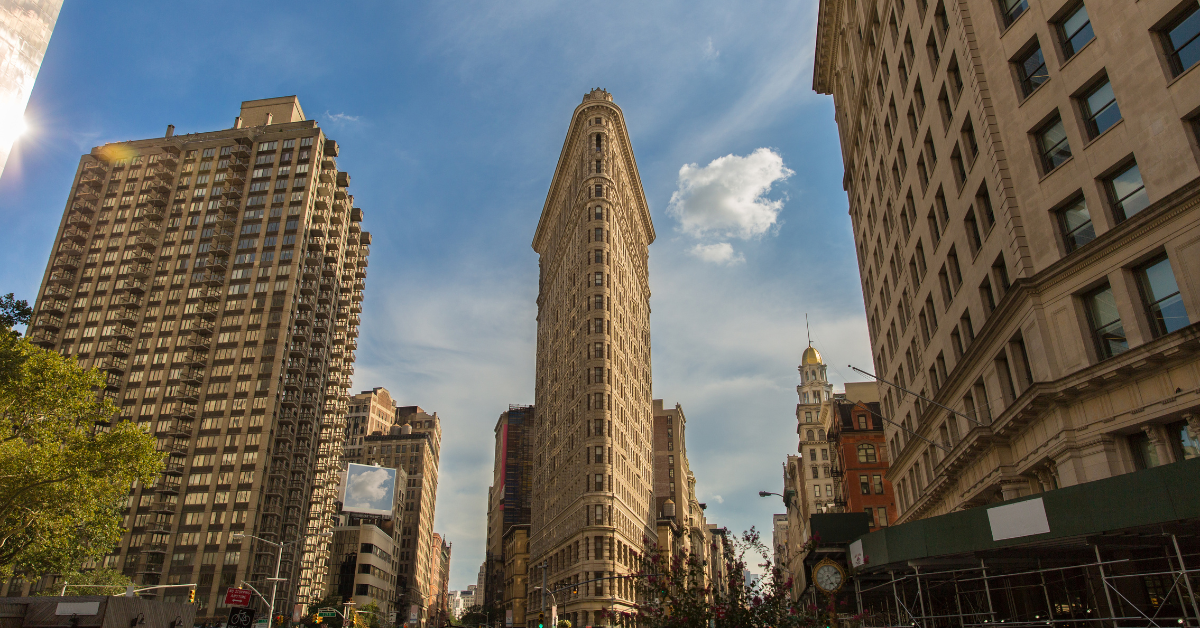The Flatiron Building, with its unique triangular shape, is not just an architectural marvel of New York but also a sacred site for Spider-Man fans. Featured as the Daily Bugle headquarters in Sam Raimi’s trilogy, it embodies both the history of the city and the cinematic legacy of Marvel’s beloved hero.
What is the Flatiron Building
The Flatiron Building was completed in 1902 and is one of the most famous landmarks in New York. Standing at about 87 meters tall, it was considered cutting-edge architecture at the time. Built on a triangular plot of land, it has a sharp, narrow form that resembles an iron, giving the building its name.
When it was first completed, its unconventional design was criticized, but over time, it came to be celebrated as a masterpiece of architectural beauty. Today, it is recognized as an emblem of New York’s skyline. The building has been depicted in countless paintings and photographs, bridging the worlds of urban culture and art.
Spider-Man and the Daily Bugle
In Sam Raimi’s Spider-Man trilogy, the exterior of the Daily Bugle, where Peter Parker worked as a photographer, was portrayed by the Flatiron Building. The scenes with editor J. Jonah Jameson criticizing Spider-Man, as well as Peter hustling as a freelance photographer, left a powerful impression on audiences.
The triangular silhouette in the background emphasized the energy of New York City itself, making the Spider-Man story feel more authentic. The choice of such an iconic building reinforced the idea that a hero exists as part of everyday life.
Moreover, the Flatiron Building has appeared in numerous films and TV dramas besides Spider-Man, solidifying its role as a cultural icon. For film lovers, it is more than just architecture; it is remembered as a “stage for stories.”
Attractions as a Tourist Spot
Even today, the Flatiron Building attracts countless visitors. Although the interior is generally not open to the public, simply viewing the exterior is worth the trip. One of the best viewpoints is from Madison Square Park, where many people stop to take photographs.
Highlights of a visit can be summarized as follows
| Tourist Point | Features | Recommended Experience |
|---|---|---|
| Exterior Photography | Unique triangular silhouette | Ideal for photography |
| Madison Square Park | Enjoy greenery along with the cityscape | Picnics and strolling |
| Nearby Cafés/Stores | Numerous places for breaks and shopping | Experience local food |
Flatiron Building and New York Culture
The Flatiron Building is renowned worldwide as a symbol of urban culture. Standing at the intersection of history and modernity, it embodies the fusion of eras within New York City. Its appearances in film and television further enhanced its fame, making it not only a tourist landmark but also a point of pride for New Yorkers.
The building is also a favorite subject for photographers and artists. Its facade changes character depending on the weather and time of day, often depicted in art as a symbol of the fusion between architecture and art.
Flatiron Building Basic Information
| Item | Details |
|---|---|
| Year Completed | 1902 |
| Height | Approx. 87 meters |
| Architect | Daniel Burnham |
| Shape | Triangular, iron-like exterior |
| Film Role | Exterior of the Daily Bugle in Spider-Man |
| Tourist Highlights | Photography, view from Madison Square Park |
Comparison with Other Spider-Man Filming Locations
The Spider-Man films feature many iconic New York locations. While the Flatiron Building is among the most famous, other sites also play important roles in shaping the story.
| Filming Location | Role in the Film | Features |
|---|---|---|
| Queens | Peter Parker’s home | Residential, down-to-earth vibe |
| Times Square | Appears in battle scenes | Symbolic entertainment district |
| Brooklyn Bridge | Emotional scenes | Historic landmark and tourist spot |
Compared to these, the Flatiron Building represents Peter’s “workplace life” and highlights his human side.
Role in a Tourist Route
When touring New York, including the Flatiron Building in a route plan allows visitors to experience the city efficiently.
| Example Route | Main Attractions | Estimated Time |
|---|---|---|
| Architecture Route | Flatiron Building → Empire State → Chrysler Building | Half day |
| Movie Location Route | Flatiron Building → Times Square → Brooklyn Bridge | Full day |
| Park Stroll Route | Flatiron Building → Madison Square → Bryant Park | Half day |
By combining these routes, visitors can enjoy architecture, cinema, and nature in one enriching journey.
Conclusion
The Flatiron Building became world-famous through the Spider-Man films. Its unique shape and historical significance make it an indispensable part of New York’s identity. Beyond its cinematic role, it is celebrated as a tourist attraction and a frequent subject in art, continuously inspiring visitors.
When visiting New York, take time to walk the streets with the Flatiron Building in view, and enjoy imagining it as part of Spider-Man’s world. With its blend of history, culture, and cinema, the building stands as both a symbol of New York and a sacred site for Spider-Man fans.






